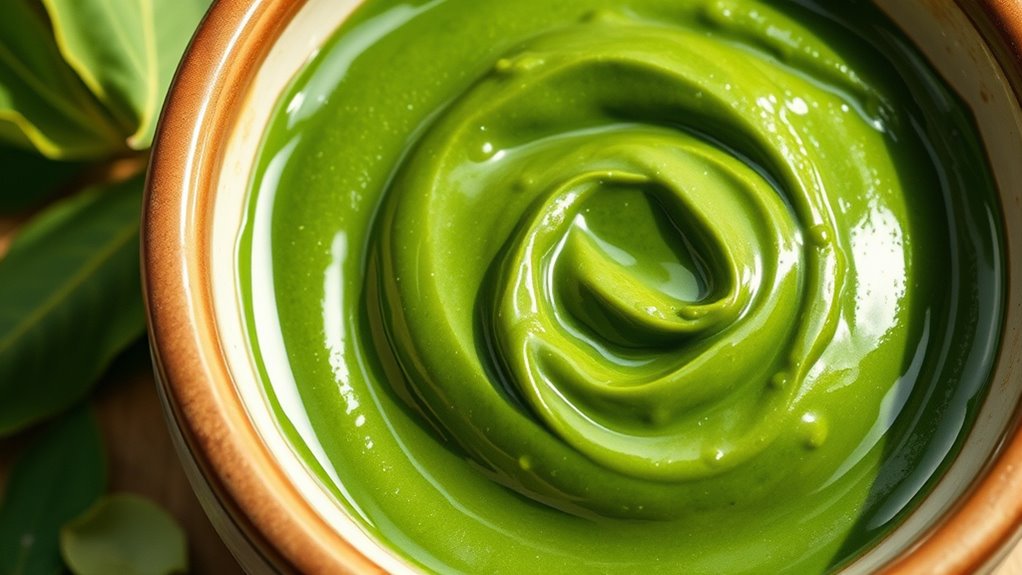This DIY Green Tea Mask Works Wonders for Acne-Prone Skin
You’ve likely heard about green tea’s antioxidant properties, like EGCG, which may help combat acne by reducing inflammation and bacteria on your skin. While this DIY mask offers potential benefits, it’s essential to approach it cautiously. Stick around to learn how to prepare and apply it safely for the best results.
Key Takeaways
- Green tea’s antioxidants combat acne-causing bacteria and reduce inflammation for clearer skin.
- Use fresh green tea leaves, honey, and yogurt to create a mask with antibacterial and soothing properties.
- Apply the mask to clean, acne-prone areas for 10-15 minutes, twice weekly, for optimal results.
- Always patch test the mask first to avoid potential irritation or allergic reactions.
- Combine regular use with a balanced skincare routine and consult a dermatologist for personalized advice.
Benefits of Green Tea for Skin
Green tea’s antioxidants, like catechins, actively combat free radicals that damage your skin.
You benefit from their anti-inflammatory effects, which studies suggest may reduce acne inflammation and promote healing.
A green tea acne mask could enhance this by delivering catechins directly, potentially minimizing breakouts through antibacterial properties.
While evidence from clinical trials indicates improvements in skin texture, results vary based on individual factors, so consult a dermatologist before trying it.
Always patch test to avoid irritation, ensuring you maximize these potential advantages safely and effectively.
Moreover, green tea aligns with the essential ingredients known for their effectiveness in acne control.
Key Ingredients Needed
To make this DIY green tea mask, you’ll need just a few essential ingredients that work together for acne-prone skin.
Drawing from natural sources, these components are supported by studies on their potential anti-acne effects, such as reducing inflammation and bacteria, while minimizing irritation risks. For further insight, these ingredients align with science-backed explanations found in effective DIY face mask recipes.
- Fresh green tea leaves: Vibrant, emerald-hued foliage rich in antioxidants, like EGCG, to soothe redness.
- Raw honey: Golden, viscous nectar from beehives, offering antibacterial properties to calm inflamed spots.
- Plain yogurt: Creamy, smooth fermented dairy with probiotics that help balance skin’s microbiome.
- Fresh lemon juice: Zesty, yellow citrus extract packed with vitamin C, but use it sparingly to avoid sensitivity.
- Ground oatmeal: Fine, earthy powder from oat grains, gently exfoliating without harsh abrasion.
How to Prepare the Mask
You’ll start by gathering the ingredients we’ve outlined, ensuring you have fresh green tea leaves or bags along with any other essentials.
Next, brew the tea properly to extract its beneficial compounds without overheating.
Finally, mix the mask components thoroughly to create a smooth, effective blend for your skin.
This homemade mask draws from DIY mask patterns to ensure it’s both effective and safe for regular use.
Gather Ingredients
Gather the essential ingredients for your green tea mask to ensure it’s effective and safe for acne-prone skin. Choose items with evidence-based benefits, like antioxidants that reduce inflammation, while being cautious of potential allergens—always patch test first.
- Fresh green tea leaves, imagine their vibrant emerald hue and earthy aroma, packed with catechins to soothe acne-prone areas.
- Raw honey, picture its golden, viscous flow, offering natural antibacterial properties to combat bacteria without drying skin.
- Plain yogurt, envision the smooth, creamy texture, delivering probiotics that support the skin’s natural barrier.
- Finely ground oatmeal, think of its soft, grainy feel, providing gentle exfoliation to unclog pores safely.
- Pure aloe vera gel, visualize its clear, cooling gel, rich in soothing compounds to calm irritation.
Brew Tea
Once you’ve gathered your ingredients, start by brewing the green tea leaves to extract their catechins, which help reduce inflammation in acne-prone skin.
Begin by heating fresh, filtered water to about 80°C (176°F) to preserve these beneficial compounds, as higher temperatures may degrade them.
Measure one teaspoon of loose green tea leaves per cup of water for optimal extraction.
Place the leaves in a strainer or teapot, then pour the water over them.
Steep for 3-5 minutes, based on studies suggesting this timing enhances anti-inflammatory effects without over-releasing tannins that could irritate sensitive skin.
Strain carefully afterward.
Mix Mask
After straining the green tea, combine it with a few essential ingredients to create an effective mask.
You’ll mix them gently to ensure even distribution, drawing on their potential benefits for acne-prone skin—always patch-test first.
- Envision pouring the warm, emerald green tea into a clean bowl, its fresh aroma filling the air.
- Add a teaspoon of raw honey, watching its viscous, golden streams integrate for possible antibacterial support.
- Stir in a dollop of plain yogurt, creating a creamy texture that hints at soothing probiotics.
- Include a pinch of turmeric, noting its vibrant yellow hue and cautious anti-inflammatory properties.
- Blend until you form a smooth, paste-like consistency, ready for gentle skin application.
Step-by-Step Application Process
To start the step-by-step application process for your DIY green tea mask, you’ll first prepare the ingredients by gathering fresh green tea and any additional components as needed.
Once that’s done, mix the mask thoroughly to ensure an even blend that won’t irritate your skin.
Then, apply the mixture gently to your acne-prone areas, using clean hands or tools to minimize the risk of contamination.
After application, allow the mask to sit for 10-15 minutes to maximize its scientific backing benefits for reducing inflammation and promoting clearer skin.
Prepare Ingredients
Gather the essential ingredients for your green tea mask to set up a straightforward preparation.
You’ll find these items promote skin health based on studies showing green tea’s anti-inflammatory effects, but always patch-test to avoid irritation.
- Vibrant green tea bags: Imagine plucking fresh leaves, rich in catechins that target acne-causing bacteria.
- Golden honey: Envision its thick, natural flow, offering antibacterial properties to calm breakouts.
- Creamy plain yogurt: Picture its smooth texture, providing probiotics that may balance skin’s microbiome.
- Zesty fresh lemon: See its bright, citric essence, which could enhance clarity but requires dilution.
- Finely ground oatmeal: Visualize its soft grains, acting as a gentle base for even application.
Mix Mask
First, combine your prepared ingredients in a clean bowl to create the mask. Gently stir with a clean spoon to form a smooth, even paste, ensuring the green tea’s antioxidants blend thoroughly with other elements.
This cautious mixing helps distribute beneficial compounds without introducing air bubbles, which could alter consistency.
Based on preliminary studies, such preparation may enhance the mask’s potential anti-acne properties, but always patch-test first and consult a dermatologist for personalized advice.
Apply Mask
Once you’ve mixed your mask, carefully apply a thin layer to clean, dry skin, starting from the forehead and working downward to ensure even coverage.
This method minimizes tugging on sensitive areas, allowing the mask’s antioxidants to potentially soothe acne-prone skin without overwhelming it.
Use clean fingers or a brush for hygiene, and avoid the eye area to prevent irritation.
- Feel the mask’s cool, silky texture glide smoothly over your forehead, like a gentle breeze on warm skin.
- Watch as the pale green mixture settles evenly on your cheeks, creating a soothing, natural barrier.
- Sense a light, refreshing tingle as it absorbs, evoking the calm of fresh tea leaves.
- Imagine your skin drinking in the nutrients, like a parched plant after rain.
- Visualize the even layer drying subtly, preparing your face for a radiant, balanced glow.
Tips for Best Results
To maximize the benefits of your DIY green tea mask, focus on a few key practices backed by skincare research.
Use freshly brewed green tea to retain potent antioxidants, as studies indicate these combat acne-causing bacteria.
Apply the mask consistently, such as twice weekly, to allow cumulative effects on inflammation.
Pair it with a balanced routine, like gentle exfoliation, for enhanced results.
Ensure you use clean tools and store mixtures in the fridge to preserve efficacy.
Always opt for high-quality ingredients to support skin barrier health without overdoing frequency.
For acne-prone skin, also consider key ingredients that target specific concerns as detailed in comprehensive guides on face masks.
Potential Side Effects and Precautions
While green tea masks are typically well-tolerated, you might encounter side effects like skin irritation or allergic reactions, especially if you have sensitive skin or underlying conditions.
To stay safe, always patch test first and discontinue use if discomfort arises.
- Envision a subtle redness spreading across your cheek, signaling early irritation that prompts immediate rinsing.
- Picture your skin feeling uncomfortably tight and flaky, a sign of over-drying from prolonged application.
- Imagine a sudden itch emerging, reminding you to avoid scratching and seek relief promptly.
- Think of consulting a dermatologist if persistent reactions occur, ensuring professional guidance.
- Visualize monitoring your face in the mirror, noting any unusual warmth as a cue to stop.
For long-term relief, consider exploring evidence-based ingredients that help calm irritation and strengthen the skin barrier.
Variations of the Green Tea Mask
Green tea masks can be customized with simple additions to address specific skin issues, such as adding honey for extra moisture or yogurt for calming effects.
You might incorporate turmeric, where studies suggest its anti-inflammatory properties could complement green tea’s benefits for acne.
For instance, blending in aloe vera may soothe irritation, based on evidence of its healing effects, but use cautiously to prevent sensitivity.
Always patch test new variations and monitor your skin’s response, as individual reactions vary.
This tailored approach lets you optimize the mask for your needs.
To combat dry skin, consider incorporating moisturizing ingredients like natural oils for enhanced hydration and relief.
Maintaining Clear Skin Long-Term
How can you sustain clear skin long-term after trying masks like the green tea one?
Consistency in your routine is essential, as research supports combining topical treatments with lifestyle habits.
Evidence from dermatological studies suggests these strategies can help, though individual results vary—always consult a professional before changes.
- Envision starting your day with a gentle, foaming cleanser that removes excess oil without irritation, leaving your skin refreshed.
- Picture incorporating antioxidant-packed meals, like a salad with spinach and berries, to combat inflammation from within.
- Imagine applying a lightweight, non-comedogenic moisturizer that hydrates without clogging pores, creating a smooth barrier.
- Think of unwinding with deep-breathing exercises, visualizing stress melting away to prevent breakouts triggered by cortisol.
- Visualize scheduling routine check-ins with a dermatologist, who reviews your progress like a trusted guide.
To maximize the benefits of these habits, always prioritize the power of consistency in your skincare approach.

